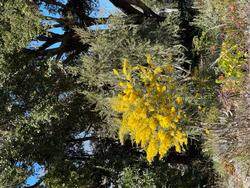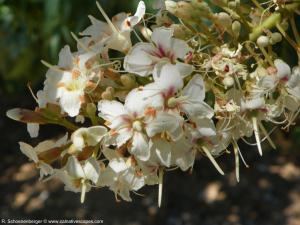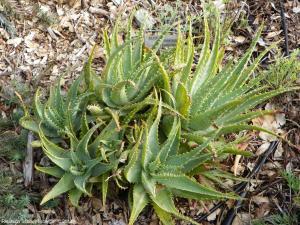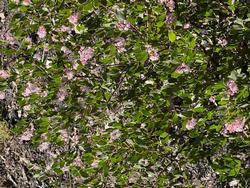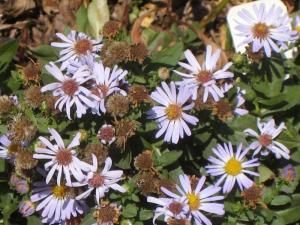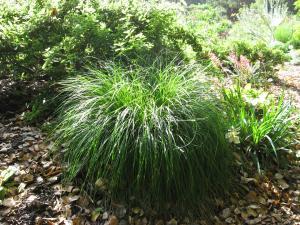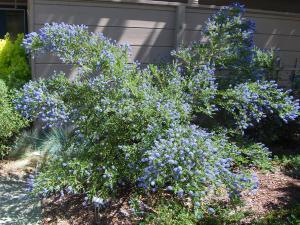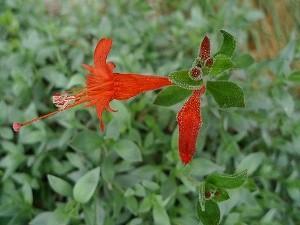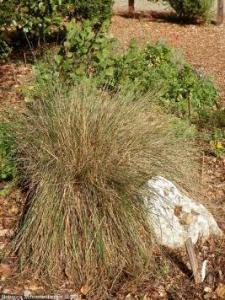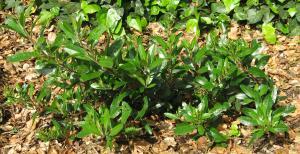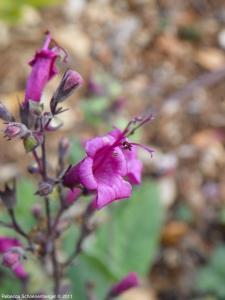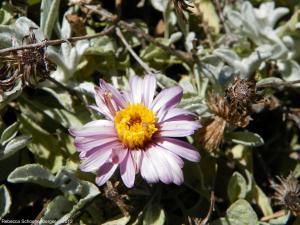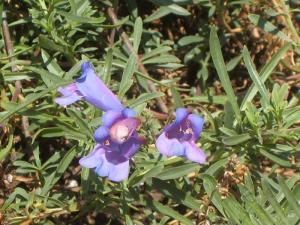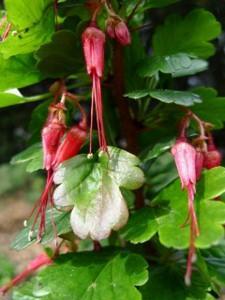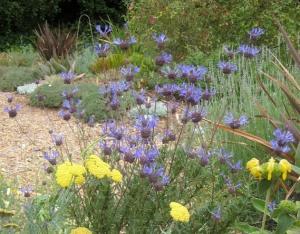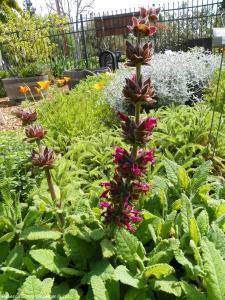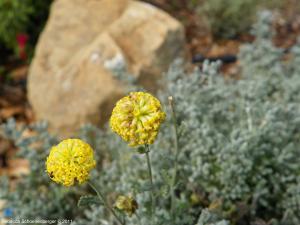Water Wise Plants
Here's a full list of all our water wise plants. You can also view an image gallery, or view the plants by categories.
Acacia cultriformis
Pronunciation
a-KAY-see-uh kul-tre-FORM-iss
Common Name
Knife-leaf acacia
Plant Type
Tree
Mature Size
10'-15' high x 10'-15' wide
Water Requirements
Very Low: water deeply several times a summer
Sun/Shade Requirements
Full sun
Wildlife
Flower Color
Yellow
Where to See
Maintenance- Design- Planting Tips
Acacia cultriformis is a tree that can reach 15' in both height and width. It has striking silver-gray leaves and is covered with vibrant yellow flowers in winter. This is a very drought tolerant tree and can go without water in summer once established. Although generally considered a problem-free tree, acacia branches can be more prone to breakage in windstorms than some other trees. Consider location carefully when planting.
PADG notes: The tree is a focal point during winter in the garden. It is pruned to a size that suits its small garden bed. During the dry season, drip irrigation is used every three weeks. |
Aesculus californica
Pronunciation
ES-kew-lus ka-li-FOR-ni-ka
Common Name
California Buckeye
Plant Type
Tree
Mature Size
Can grow 10 - 25 ft. or more, and spread 30 ft. or wider
Water Requirements
Very Low: water deeply several times a summer
Sun/Shade Requirements
Full to half sun, shade
Wildlife
Flower Color
White to pink
Where to See
Maintenance- Design- Planting Tips
The California buckeye is an unusual native because it is summer deciduous. It will naturally drop its leaves with the heat of summer, but with regular watering it may hold leaves longer. Its nectar/pollen is poisonous to European honeybees, but not to native bees. The flower has a candy or perfume-like scent, and blooms in very early spring.
The tree produces a large nut that resembles a buck's eye, thus the name. The nut is poisonous to eat. The nuts easily reseed where they fall, so collect them if new sprouts are not desired. Without summer leaves, the pale bark of the California buckeye offers interest and structure in the garden and is very easy to prune and shape. |
Aloe x spinosissima
Pronunciation
AL-oh spin-oh-Siss-e-ma
Common Name
Spider Aloe
Plant Type
Succulent
Mature Size
2-3 ft. high, 2-4 ft. wide
Water Requirements
Very Low: water deeply several times a summer
Sun/Shade Requirements
Full to half sun, shade
Wildlife
Flower Color
Red-orange
Where to See
Maintenance- Design- Planting Tips
Spider aloe is a slow-growing succulent, making it unlikely to outgrow its space or crowd its neighbors. This low-maintenance plant is an excellent specimen for a small low-water garden.
It’s a striking plant with an interesting form – it almost looks like a piece of modern sculpture. Spider aloe is frost-tender so be sure to protect it on cold winter nights. PADG notes: In the winter, spider aloe is rumored to have red flower spikes that are attractive to hummingbirds. Unfortunately, this cannot be confirmed because the plant has never bloomed in our location. |
Arctostaphylos densiflora ‘Howard McMinn’
Pronunciation
ark-toe-STAF-i-los den-si-FLOR-us
Common Name
Manzanita ‘Howard McMinn’
Plant Type
Shrub
Mature Size
5-7 ft tall x 6-10 ft wide
Water Requirements
Very Low: water deeply several times a summer
Sun/Shade Requirements
Full to half sun
Wildlife
Flower Color
Whitish pink
Maintenance- Design- Planting Tips
California native Arctostaphylos ‘Howard McMinn’ is reputed to be the manzanita most tolerant of typical garden conditions. Manzanitas in general need excellent drainage. In heavy clay soils, be careful not to over water or over fertilize.
If the tips of Arctostaphylos branches are pruned, this large shrub will become very dense and make a good privacy screen. Removing the interior stems and leaves instead exposes the interesting red bark. The latter is a good approach for making the shrub more of a focal point instead of a background plant. PADG notes: PADG planted three ‘Howard McMinn’ manzanitas at the entrance of the Water Wise Garden. They have struggled there over the years, damaged by foot traffic and the occasional joy rider. |
Aster chilensis
Pronunciation
ASS-ter chil-EN-sis
Common Name
California Aster
Plant Type
Perennial
Mature Size
2 ft. to 3 ft. wide and 18 in. to 3 ft. tall
Water Requirements
Very Low: water deeply several times a summer
Sun/Shade Requirements
Full to half sun
Wildlife
Flower Color
Purple, pale blue or white
Where to See
Maintenance- Design- Planting Tips
This California native is a low growing, late summer bloomer that shines when much of the garden is quiet. It works well in the front of a low water perennial bed or native plant border.
California aster looks best if regularly deadheaded. After it is done blooming in the fall, shear it back to the ground to keep a tidy look in the garden. The plant will cheerfully return when winter is over. PADG notes: California aster spread very rapidly even without supplemental water. It might work better in a situation where a rapidly spreading plant is needed for erosion control rather than in a small, mixed perennial bed. |
Calochortus luteus
Pronunciation
ka-lo-KOR-tus LU-teus
Common Name
Yellow Mariposa Lily
Plant Type
Perennial
Mature Size
.5 ft (0.2 m) wide x 1.6 ft (0.49 m) tall
Water Requirements
Very Low: water deeply several times a summer
Sun/Shade Requirements
Full to half sun
Wildlife
Flower Color
Yellow
Where to See
Maintenance- Design- Planting Tips
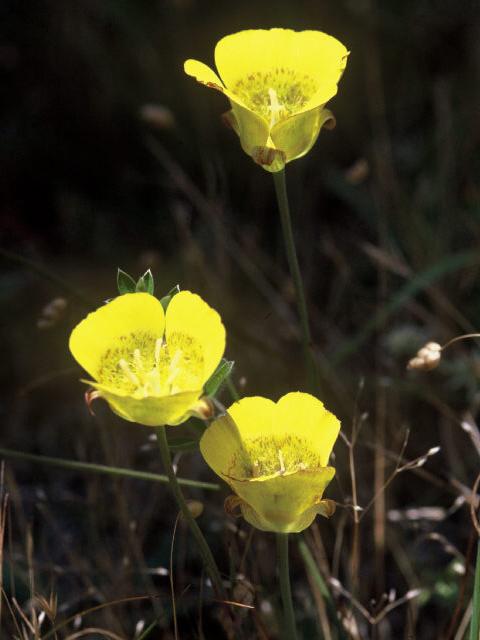
|
Carex divulsa
Pronunciation
KARE-eks dee-VOOL-sah
Common Name
Foothill Sedge
Plant Type
Grass
Mature Size
2 ft. tall and 1 ft. wide
Water Requirements
Very Low: water deeply several times a summer
Sun/Shade Requirements
Full to half sun, shade
Wildlife
Flower Color
No flowers
Where to See
Maintenance- Design- Planting Tips
Foothill sedge makes a lovely informal ground cover in shady areas. With occasional watering, this plant stays green over the entire summer. It will survive full sun but can begin to look ratty in the summer.
This plant was once considered a California native, but that has recently been disproven. The new name is Carex divulsa, but it may still be sold in nurseries as Carex tumulicola. PADG notes: At the end of winter, many people cut this plant back to several inches above the ground, but that has not been necessary at the demonstration garden. Because plants are in the shade, they don’t become tattered. Reseeding has also not been a problem, probably because of extensive bark mulch and drip irrigation in the water wise garden. |
Ceanothus ‘Concha’
Pronunciation
see-a-NO-thus
Common Name
California Wild Lilac ‘Concha’
Plant Type
Shrub
Mature Size
6-8 ft tall x 6-8 ft wide
Water Requirements
Very Low: water deeply several times a summer
Sun/Shade Requirements
Full to half sun
Wildlife
Flower Color
Blue
Where to See
Maintenance- Design- Planting Tips
Ceanothus ‘Concha’ is a California native plant with rose colored buds that open to cobalt blue flowers in late winter or early spring. Leaves are small and a deep dark green.
‘Concha’ is one of the best Ceanothus cultivars for Santa Clara County. It is more adaptable to typical garden environments than many other Ceanothus, tolerating heavy clay soil, drought, or summer watering. Overwatering will shorten the life of any Ceanothus so be sure to allow the soil to dry between waterings. |
Epilobium ‘Select Mattole’
Pronunciation
Ep-ih-LOW-bee-um
Common Name
Hummingbird Fuchsia ‘Select Mattole’
Plant Type
Shrub
Mature Size
1 ft tall and 2 ft. wide
Water Requirements
Very Low: water deeply several times a summer
Sun/Shade Requirements
Full to half sun
Wildlife
Flower Color
Red orange
Where to See
Maintenance- Design- Planting Tips
California native fuchsias are a welcome addition to the waterwise garden. They produce masses of red-orange flowers all summer long, at a time when many other native plants are dormant. Hummingbirds love these tubular flowers. ‘Select Mattole’ is one of many cultivars available. Its silver-green foliage foliage shines in the garden. It stays compact and doesn't spread.
Cut California fuchsias back to one inch stubs in the fall or winter. For varieties that tend to ranginess, pinching the outer tips in late May or June will encourage them to be denser and less floppy. California fuchsias are drought tolerant and can be completely summer dry, but will be lusher if given a once a month deep watering. |
Festuca californica
Pronunciation
fess-TEW-kuh kal-ih-FOR- nih-kuh
Common Name
California Fescue
Plant Type
Grass
Mature Size
2 ft. high and wide, with inflorescence 2 - 3 ft. high
Water Requirements
Very Low: water deeply several times a summer
Sun/Shade Requirements
Full to half sun, shade
Wildlife
Flower Color
Golden
Where to See
Maintenance- Design- Planting Tips
Festuca californica is a commonly planted California native grass. It is larger than many of the Festucas, reaching two feet or more in height and has a softer more arching habit. Unlike many California natives, this plant can take moderate water and will stay green and lush with regular watering. Without regular summer watering, it will go dormant. Festuca californica is tough and resilient. To prevent reseeding, be sure to deadhead in early summer.
|
Grindelia hirsutula
Pronunciation
grin-DELL-ee-a hir-SU-too-la
Common Name
Great Valley Gumweed
Plant Type
Perennial
Mature Size
3 ft. wide x 2 - 6.6 ft (0.6 - 2 m) tall
Water Requirements
Very Low: water deeply several times a summer
Sun/Shade Requirements
Full sun
Wildlife
Flower Color
Yellow
Where to See
Maintenance- Design- Planting Tips
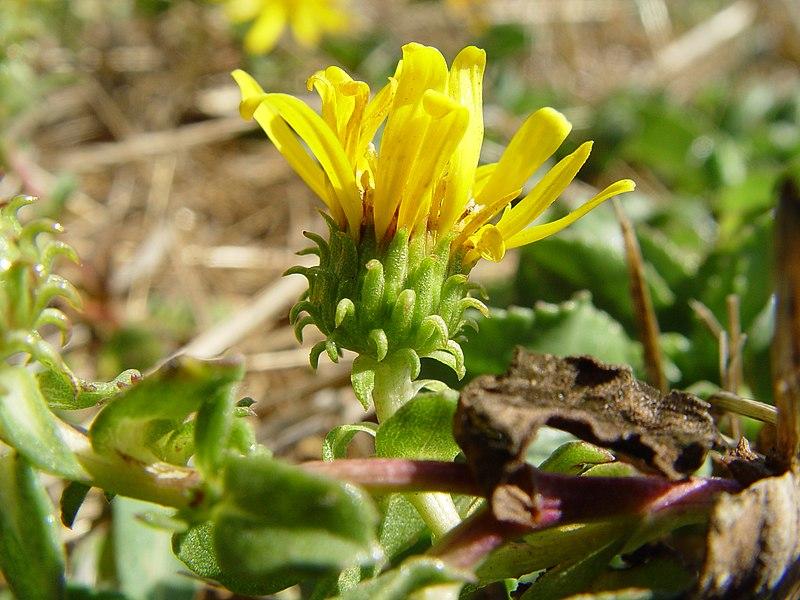
|
Heteromeles arbutifolia
Pronunciation
het-er-OH-mi-lees ar-bew-ti-FO-lee-a
Common Name
Toyon
Plant Type
Shrub
Mature Size
10-20 ft tall x 10-15 ft wide
Water Requirements
Very Low: water deeply several times a summer
Sun/Shade Requirements
Full to half sun
Wildlife
Flower Color
White
Maintenance- Design- Planting Tips
Toyon is an attractive dark green, large shrub that can develop into a small multi-trunk tree. This plant is native to many chaparral areas of California and easily adapts to garden cultivation.
It is a member of the rose family, producing small white flowers in early spring followed by showy red berries. The berries remain on the shrub for several months while they slowly ripen. Once ripe, they attract many different species of hungry, grateful birds. Young toyons may take a few years to settle into the garden but once established, they are easy to grow and can be pruned to manage their size or to keep them looking fresh. PADG notes: The toyon in the Palo Alto Demo Garden Water Wise Garden was planted in the winter of 2008 from a one-gallon container in a spot where it gets afternoon shade. This toyon is still a modest sized shrub many years after planting. |
Lepechinia hastata
Pronunciation
le-peh-KIN-ee-uh hass-TAH-tuh
Common Name
Pitcher Sage
Plant Type
Shrub
Mature Size
3 ft. tall and wide in low water gardens
Water Requirements
Very Low: water deeply several times a summer
Sun/Shade Requirements
Full to half sun
Wildlife
Flower Color
Magenta
Where to See
Maintenance- Design- Planting Tips
Pitcher sage is an aromatic member of the mint family that is attractive in wild gardens. In late summer these plants have reddish purple flowers on medium-sized spikes. Hummingbirds and bees love them, so they add quite a bit of life to a garden. Another feature is the plant’s large leaves, which offer a nice contrast to many plants from the Mediterranean region that have smaller foliage. Although some pitcher sages are native to California, Lepechinia hastata is from Mexico.
PADG notes: Some reference books say this plant can get up to 6 feet tall, but in the Palo Alto Demonstration Garden, they have stayed a modest 3 feet tall and wide. The trick may be not to overwater them. |
Lessingia filaginifolia
Pronunciation
les-IN-jee-a fi-la-jin-i-FOL-ee-a
Common Name
California Dune Aster
Plant Type
Groundcover
Mature Size
3+ ft. wide and 4 in. tall
Water Requirements
Very Low: water deeply several times a summer
Sun/Shade Requirements
Full to half sun
Wildlife
Flower Color
Pink to lilac
Where to See
Maintenance- Design- Planting Tips
Lessingia felaginifolia is a drought tolerant California native groundcover and a favorite with butterflies. Lessingia ‘Silver Carpet’ is a selection known for its dense, silvery foliage. The short, ground-hugging foliage is only 4 inches high, spreading 3 or more feet. Water deeply a few times over the summer.
|
Penstemon 'Margarita BOP'
Pronunciation
PEN-steh-mon
Common Name
Foothill Penstemon
Plant Type
Perennial
Mature Size
1 ft. to 2 ft. wide, 2 ft. to 3 ft. tall
Water Requirements
Very Low: water deeply several times a summer
Sun/Shade Requirements
Full to half sun
Wildlife
Flower Color
Where to See
Maintenance- Design- Planting Tips
Penstemon 'Margarita BOP' is a UC Davis “All-Star” because it does well in average garden conditions. Unlike many other California native plants, Foothill penstemon can tolerate some summer water. The bright blue flowers on these plants are stunning and last well into late summer, especially if deadheaded regularly.
|
Ribes speciosum
Pronunciation
RIE-bees spes-ee-OH-sum
Common Name
Fuchsia Flowering Gooseberry
Plant Type
Shrub
Mature Size
4-8 ft tall x 6-10 ft wide
Water Requirements
Very Low: water deeply several times a summer
Sun/Shade Requirements
Full to half sun, shade
Wildlife
Flower Color
Red
Where to See
Maintenance- Design- Planting Tips
This California native is a large, spiny shrub that can exist with no summer irrigation. Ribes speciosum will go fully dormant during the summer, therefore it is not recommended as a summer focal plant. As soon as the winter rains begin, the plant will unfold glossy green leaves and fuchsia-like red flowers that bloom all winter. The flowers that hang along the undersides of the long arching branches are loved by hummingbirds.
Because of the spiny branches, this shrub should be kept away from walks. It makes a formidable barrier. |
Salvia clevelandii
Pronunciation
SAL-vee-uh kleev-LAN-dee-eye
Common Name
Cleveland Sage
Plant Type
Shrub
Mature Size
3 ft. wide and tall
Water Requirements
Very Low: water deeply several times a summer
Sun/Shade Requirements
Full sun
Wildlife
Flower Color
Where to See
Maintenance- Design- Planting Tips
'Winnifred Gilman' is a compact Salvia cultivar with violet-blue flowers that bloom in late spring. The grey-green foliage of this California native smells like a chaparral morning.
Like many sages, these are short-lived plants. Even with regular pruning, Salvia clevelandii needs to be replaced every five to ten years when the stems become woody. PADG Notes: 'Winnifred Gilman' is pruned back by about a third in the late summer and early fall to prolong the life of the plant and maintain a nice shape. To learn more about Salvias, we suggest reading Betsy Clebsch's The New Book of Salvias |
Salvia spathacea
Pronunciation
SAL-vee-a spa-THAY-see-a
Common Name
Hummingbird Sage
Plant Type
Perennial
Mature Size
1-2 ft high x spreading
Water Requirements
Very Low: water deeply several times a summer
Sun/Shade Requirements
Full to half sun, shade
Wildlife
Flower Color
Red
Where to See
Maintenance- Design- Planting Tips
Salvia spathacea is a California native plant with an unusually (for California natives) lush appearance. The leaves of this plant are large and can grow up to a foot in length.
The plant spreads by underground rhizomes and can eventually cover a large area. Hummingbird sage can make a colorful ground cover in dry, shady conditions. From spring until fall, flowering stems appear above the foliage. The flower clusters are spaced evenly along the stems creating a bold vertical accent. Light pruning after blooming will help keep this plant neat. PADG Notes: In the PADG Water Wise Garden, we found that too much summer sun burned the leaves and made the plant unattractive. Also, our hummingbird sage spread more aggressively than had been anticipated. A few runners were replanted to shadier spots under oak trees and will be monitored carefully. |
Santolina chamaecyparissus 'Nana'
Pronunciation
san-toh-LEE-nuh kam-ee-ky-par-ISS-us
Common Name
Dwarf Lavender Cotton
Plant Type
Perennial
Mature Size
2 ft. tall and 3 ft. wide
Water Requirements
Very Low: water deeply several times a summer
Sun/Shade Requirements
Full to half sun
Wildlife
Flower Color
Where to See
Maintenance- Design- Planting Tips
Santolina chamaecyparissus 'Nana' is a compact shrub with silver grey foliage and bright yellow flowers. This cultivar is very slow growing and stays a nice size.
PADG Notes: We originally had a full sized Santolina, but the plant fell apart when it bloomed. It was unattractive, so it was removed it from the garden. Santolina chamaecyparissus 'Nana' is a good choice for an edger or in a knot garden because it doesn't require the pruning that the larger species needs. We've used short silver plants as edging throughout the Demonstration Garden to tie the garden together visually. |







